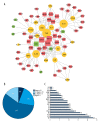Network Pharmacology-Based Analysis on the Mechanism of Action of Ephedrae Herba-Cinnamomi Ramulus Couplet Medicines in the Treatment for Psoriasis
- PMID: 33513128
- PMCID: PMC7852043
- DOI: 10.12659/MSM.927421
Network Pharmacology-Based Analysis on the Mechanism of Action of Ephedrae Herba-Cinnamomi Ramulus Couplet Medicines in the Treatment for Psoriasis
Abstract
BACKGROUND This study explored the mechanism of action of Ephedrae Herba-Cinnamomi Ramulus couplet medicine (MGCM) at the pharmacological level in the treatment of psoriasis. MATERIAL AND METHODS The active ingredients in MGCM were mined through literature retrieval and the BATMAN-TCM database, and potential targets were predicted. In addition, targets associated with psoriasis were acquired using multiple disease-related databases. Thereafter, an interaction network between candidate MGCM targets and the known psoriasis-associated targets was constructed based on the protein-protein interaction (PPI) data, using the STRING database. Then, the topological parameter degree was determined for mining the core targets for MGCM in the treatment of psoriasis, which also represented the major hubs within the PPI network. In addition, the core networks of targets and ingredients were constructed using Cytoscape software to apply MGCM in the treatment for psoriasis. These core targets were then analyzed for Gene Ontology biological processes and Kyoto Encyclopedia of Genes and Genomes pathway enrichment using OmicShare. RESULTS The ingredient-target core network of MGCM for treating psoriasis was constructed; it contained 52 active ingredients and corresponded to 19 core targets. In addition, based on enrichment analysis, these core targets were majorly enriched for several biological processes (immuno-inflammatory responses, leukocyte differentiation, energy metabolism, angiogenesis, and programmed cell death) together with the relevant pathways (Janus kinase-signal transducer and activator of transcription, toll-like receptors, nuclear factor kappaB, vascular endothelial growth factor, and peroxisome proliferator-activated receptor), thus identifying the possible mechanism of action of MGCM in treating psoriasis. CONCLUSIONS The present network pharmacology study indicated that MGCM alleviates various pathological factors of psoriasis through multiple compounds, multiple targets, and multiple pathways.
Conflict of interest statement
None.
Figures




References
-
- Chiang CC, Cheng WJ, Lin CY, et al. Kan-Lu-Hsiao-Tu-Tan, a traditional Chinese medicine formula, inhibits human neutrophil activation and ameliorates imiquimod-induced psoriasis-like skin inflammation. J Ethnopharmacol. 2020;246:112246. - PubMed
MeSH terms
Substances
LinkOut - more resources
Full Text Sources
Other Literature Sources
Medical

